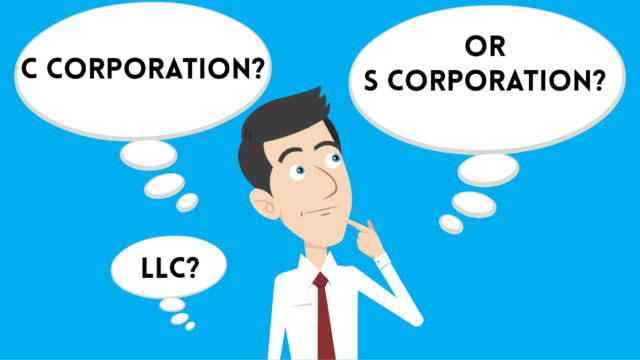
Any new or established business looking to become incorporated has to ponder one significant factor: whether or not they should become an S corporation or a C corporation. While both could be worthwhile in many respects, there will undoubtedly be one corporation style that provides the most benefits for your unique business structure. If you’re not yet sure which it will be, it may pay to consider the following information:
What Is an S Corporation?

An S corporation, also referred to as S subchapter, is a corporation type that abides by set requirements of the Internal Revenue Code. When it meets those set requirements, your income, losses, deductions, and credits may pass to the shareholders without you needing to pay federal corporate taxes.
This corporation style is popular with many businesses with 100 or fewer shareholders. They get to enjoy the benefits of incorporation along with some of the tax-exempt benefits of partnerships.
How it works is reasonably straightforward. Shareholders pay taxes at their ordinary tax rates after reporting their income and losses on individual tax returns. To be eligible, the business must be incorporated domestically within the U.S. with one class of stock and have no more than 100 shareholders who meet another set of eligibility requirements.
What Is a C Corporation?

A C corporation, also called C-Corp for short, allows shareholders and business owners to be taxed separately from their entity. They are subject to corporate income taxes, and profits are taxed at personal and corporate levels. This is called double taxation.
Even though S corporations are comparable in the respect that they also separate the assets of the business and its owners, C corporations are slightly different. The liability of investors and firm owners is limited to how much they have invested in their company, and C corporations also have a board of directors voted by shareholders.
Why Businesses Choose the S Corporation Status

There are many reasons why business owners choose the S corporation status. However, three of the main advantages revolve around income, taxes, and losses.
No Corporate-Level Income Tax
Instead of paying corporate-level tax, income is distributed to each of the shareholders and is then taxed at an individual level, regardless of whether that income is earned in person or online.
Pass-Through of Losses
Any losses of an S corporation are passed through to its shareholders. They can offset the losses against their income as long as they do so within the restrictions of tax laws.
One Tax Layer
Unlike C corporations with two tax layers, S corporations only have one. They don’t pay a corporate-level income tax, which means income is taxed at the individual level.
Drawbacks of S Corporations

Even with all the aforementioned benefits of S corporations, there are some drawbacks that are worth being aware of before you make your decision.
Share Selling and Transfer Restrictions
Typically, there are limitations around your ability to transfer or sell shares. As a result, shareholders can find it challenging to leave the corporation. If shares are transferred to someone who is ineligible, the IRS may terminate your S corporation status.
Shareholder Restrictions
You may only have up to 100 shareholders within your corporation. This means you may not be able to raise capital from new investors if you need to. Aside from a few exceptions, shareholders must also be US citizens or residents and only individuals. These restrictions may make it harder to receive equity financing.
Stock Limitations
As an S corporation, you can only have one class of stock. If you are already an established business looking to become incorporated, multiple stock types can see S corporation as an unfeasible option.
Why Businesses Choose the C Corporation Status

Out of all corporation types, C corporations are the most common. There can often be more flexibility for business owners, particularly those who are already well established before deciding to become incorporated.
No Ownership Restrictions
Business entities, non-U.S. citizens, and almost anyone else can own shares in your business if it has a C corporation status. There is also no limit on how many shareholders you can have.
No Stock Limitations
You may have more than one stock type, including dividends and distributions.
Tax Benefits
The corporate tax rate is 21%, which is lower than the highest personal tax rate of 37%.
Drawbacks of C Corporations

Even though C corporations have many desirable benefits, that doesn’t mean businesses wouldn’t experience some drawbacks compared to if they decided to become an S corporation.
Double Taxation
C corporations pay tax on both the business earnings and shareholder dividends even though you may benefit from a lower corporate tax rate. Essentially, this means your earnings are taxed twice.
More Regulations
There is more government oversight connected to C corporations. This is because the corporation owners are protected from debts and lawsuits.
No Corporate Loss Deductions
Unlike S corporations, shareholders of a C corporation can’t deduct their losses on their personal tax returns.
How to Form an S Corporation

Once you’ve decided that an S corporation is the right option for your unique business model, it’s time to put a plan into action. Submit Form 2553 Election by a Small Business Corporation, and have all shareholders sign it. You can then file this form with the IRS.
If you need a helping hand, your chosen lawyer can assist with the entire process, including making sure it’s the right option for you. You can visit this site to learn more.
How to Form a C Corporation

If your lawyer has recommended a C corporation, they can walk you through the steps to become incorporated.
Forming a C corporation can involve choosing and reserving a legal name before filing your Articles of Incorporation with the Secretary of State.
Stock certificates are then issued to the initial shareholders, and you can apply for a business license and certificates for your industry. The next steps involve filing the SS-4 form or visiting the IRS website to receive your employer identification number. You may require other ID numbers so you can pay disability, unemployment, and payroll taxes.
Even though there can be a lot involved in deciding whether to become an S or C corporation, doing your homework may help with making your decision. Weigh up the pros and cons of each option, and seek legal representation. You can be on your way to becoming an official corporation in no time.












